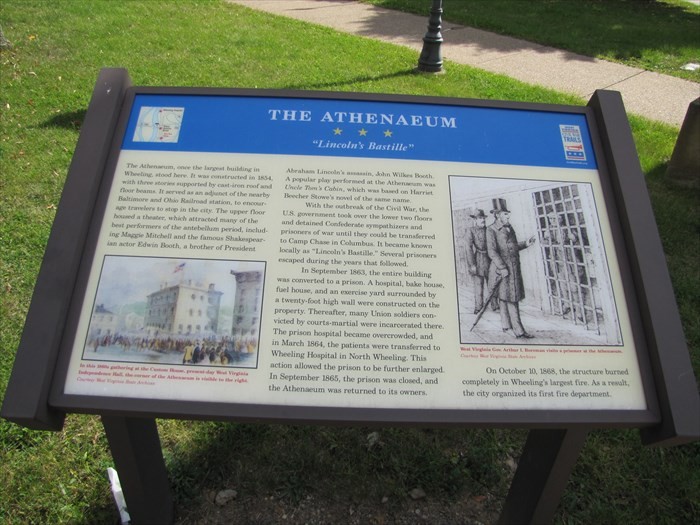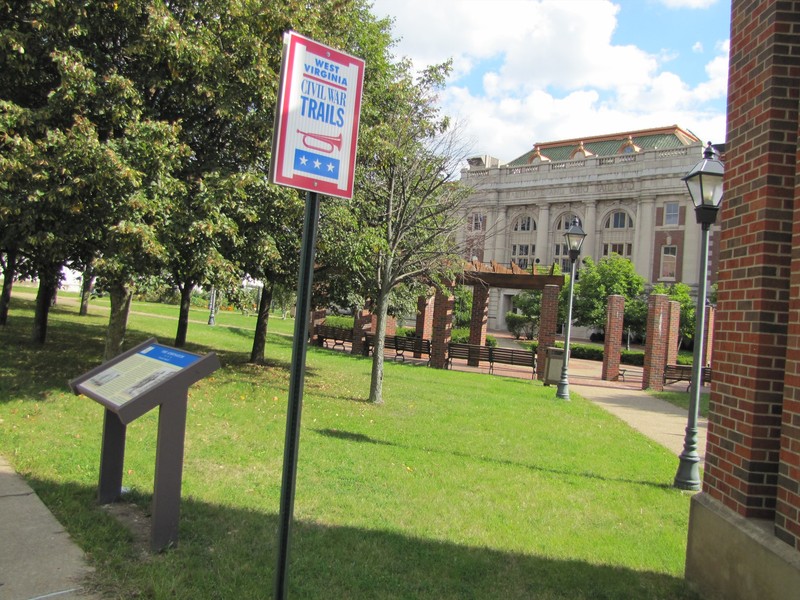The Athenaeum - "Lincoln's Bastille"
Introduction
Text-to-speech Audio
Images
The Athenaeum historical marker

Small park where The Athenaeum once stood

Backstory and Context
Text-to-speech Audio
The building was constructed between 1853 and 1854 and designed to serve as a warehouse for Crescent Manufacturing Company. This Wheeling-based company produced iron rails and other materials for the neighboring B & O Railroad. The company utilized the first and second stories of the building. They rented the top floor out as a theater called the Athenaeum. The theater opened in January 1855 and was quite popular throughout the Wheeling area, with residents traveling many miles to attend performances of “Uncle Tom’s Cabin” and other traveling shows. The Athenaeum even included performances by Edwin Booth, brother of John Wilkes Booth.
The Athenaeum's first performance was on Jan. 27, 1855, and was provided by a traveling show company. A heating system was installed for the customers' comfort as they watched the various shows provided by the theatre. According to one of the local Wheeling newspapers, the theater was one of the best between the Allegheny Mountains and Chicago. "In April 1856, the managers tried to attract a better class of audience and provided omnibuses to take the gentry home after the performance. Police were stationed in the theater to discourage the riff-raff, and the admission charge was 50 cents for the parquette and dress circle and 25 cents for the balcony."1
During the war, the Union used the building as a prison, referred to many as the Athenaeum prison or "Lincoln's Bastile." In the fall of 1861, 50 secessionist prisoners from Camp Carlile, the Union training camp on Wheeling Island, took over the second floor of the building. These first prisoners only stayed a few days until they were moved to Camp Chase near Columbus, Ohio. By December of 1861, prisoners would number close to a hundred some days, and this presence effectively closed the theater. It was at this time that the name “Lincoln’s Bastille” began being used by rebel prisoners. While the first prisoners housed here were mainly Confederates, by 1863 as more Union prisoners arrived, the United States military took over the entire building for more space to keep the prisoners separated. The government worked to make the prison self-sufficient, adding kitchens, barracks, and a hospital to the property. The prison held captured Confederate prisoners, rebel spies, court-martialed Union soldiers, civilians who refused to pledge their oath of allegiance, and bushwhackers. Numbers of prisoners held at The Athenaeum would range from 50-60 to well over a hundred at times.
Sick and wounded soldiers would be taken care of at the prison by visiting Sisters of St. Joseph from nearby Wheeling Hospital. These sisters played a large part in the history of nursing in West Virginia as they performed the first nursing duties in the state in Wheeling. The sisters would care for soldiers from both the North and the South at The Athenaeum. As the war went on, the small hospital at the prison became overcrowded, and so on March 31, 1864, 45 patients were moved to Wheeling Hospital, which had by this time been taken over by the military as well.
The Athenaeum prison closed in 1865. After the war, a malt storage was housed in the basement and Mr. Fairfax, the architect of the city of Wheeling, had a small office in an adjoining building. In October of 1868 The Athenaeum caught fire and burned to the ground. It was the largest fire in Wheeling’s history at the time. The inadequacy of the Wheeling fire department to save the building prompted them to make improvements and purchase steam fire engines. While only surviving fourteen short years, this building played a large part in the Civil War history of West Virginia. It is now largely forgotten and a private park now stands in its place today.
